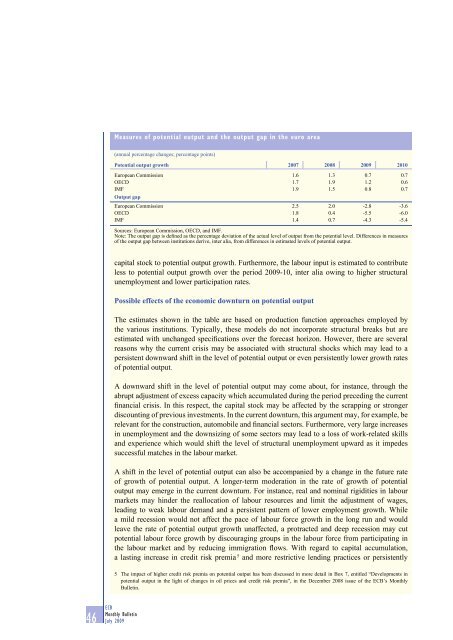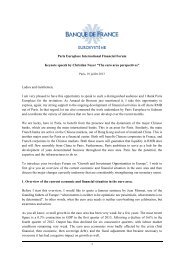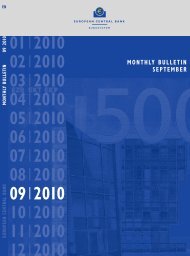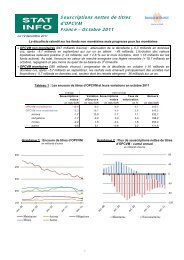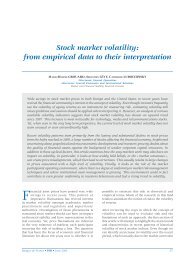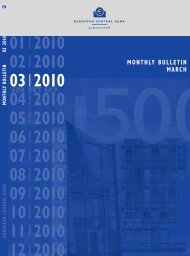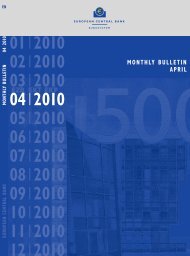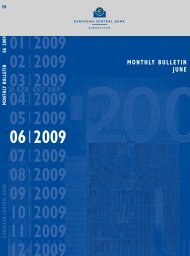Monthly Bulletin July 2009 - Banque de France
Monthly Bulletin July 2009 - Banque de France
Monthly Bulletin July 2009 - Banque de France
You also want an ePaper? Increase the reach of your titles
YUMPU automatically turns print PDFs into web optimized ePapers that Google loves.
Measures of potential output and the output gap in the euro area<br />
(annual percentage changes; percentage points)<br />
Potential output growth 2007 2008 <strong>2009</strong> 2010<br />
European Commission 1.6 1.3 0.7 0.7<br />
OECD 1.7 1.9 1.2 0.6<br />
IMF 1.9 1.5 0.8 0.7<br />
Output gap<br />
European Commission 2.5 2.0 -2.8 -3.6<br />
OECD 1.8 0.4 -5.5 -6.0<br />
IMF 1.4 0.7 -4.3 -5.4<br />
Sources: European Commission, OECD, and IMF.<br />
Note: The output gap is <strong>de</strong>fined as the percentage <strong>de</strong>viation of the actual level of output from the potential level. Differences in measures<br />
of the output gap between institutions <strong>de</strong>rive, inter alia, from differences in estimated levels of potential output.<br />
capital stock to potential output growth. Furthermore, the labour input is estimated to contribute<br />
less to potential output growth over the period <strong>2009</strong>-10, inter alia owing to higher structural<br />
unemployment and lower participation rates.<br />
Possible effects of the economic downturn on potential output<br />
The estimates shown in the table are based on production function approaches employed by<br />
the various institutions. Typically, these mo<strong>de</strong>ls do not incorporate structural breaks but are<br />
estimated with unchanged specifications over the forecast horizon. However, there are several<br />
reasons why the current crisis may be associated with structural shocks which may lead to a<br />
persistent downward shift in the level of potential output or even persistently lower growth rates<br />
of potential output.<br />
A downward shift in the level of potential output may come about, for instance, through the<br />
abrupt adjustment of excess capacity which accumulated during the period preceding the current<br />
financial crisis. In this respect, the capital stock may be affected by the scrapping or stronger<br />
discounting of previous investments. In the current downturn, this argument may, for example, be<br />
relevant for the construction, automobile and financial sectors. Furthermore, very large increases<br />
in unemployment and the downsizing of some sectors may lead to a loss of work-related skills<br />
and experience which would shift the level of structural unemployment upward as it impe<strong>de</strong>s<br />
successful matches in the labour market.<br />
A shift in the level of potential output can also be accompanied by a change in the future rate<br />
of growth of potential output. A longer-term mo<strong>de</strong>ration in the rate of growth of potential<br />
output may emerge in the current downturn. For instance, real and nominal rigidities in labour<br />
markets may hin<strong>de</strong>r the reallocation of labour resources and limit the adjustment of wages,<br />
leading to weak labour <strong>de</strong>mand and a persistent pattern of lower employment growth. While<br />
a mild recession would not affect the pace of labour force growth in the long run and would<br />
leave the rate of potential output growth unaffected, a protracted and <strong>de</strong>ep recession may cut<br />
potential labour force growth by discouraging groups in the labour force from participating in<br />
the labour market and by reducing immigration flows. With regard to capital accumulation,<br />
a lasting increase in credit risk premia 5 and more restrictive lending practices or persistently<br />
5 The impact of higher credit risk premia on potential output has been discussed in more <strong>de</strong>tail in Box 7, entitled “Developments in<br />
potential output in the light of changes in oil prices and credit risk premia”, in the December 2008 issue of the ECB’s <strong>Monthly</strong><br />
<strong>Bulletin</strong>.<br />
46 ECB<br />
<strong>Monthly</strong> <strong>Bulletin</strong><br />
<strong>July</strong> <strong>2009</strong>


